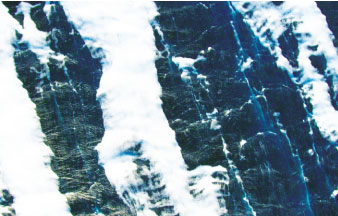
Unmanned aircraft take hardiness to Antarctic extremes
With a click and release, a small white and orange-tipped plane lifted off from the roof of a truck racing down an icy runway. With barely a wobble, the unmanned aircraft swooped into the white sky above the Antarctic, launched by researchers on the ground. For the duration of its flight, the robotic plane would be largely on its own as it collected data from such hard-to-reach and extreme environments as Antarctica.
This unmanned aircraft logged a series of record-setting research flights in its tenure in Antarctica in 2009, providing CIRES researchers and colleagues with some of the first three-dimensional observations of gaping holes in the Antarctic sea ice, known as polynyas, and the blasting winds that help form them.
"These were some of the longest flights on record for scientific applications, and certainly the longest in Antarctica," said CU-Boulder Research Professor James Maslanik.
Using unmanned planes roughly 9 feet across, Maslanik and CIRES Fellow and Associate Professor John Cassano gained a unique glimpse into the Terra Nova Bay polynya, a stretch of open water that at times yawns 2,000 square miles in area, nearly twice the size of Rhode Island.
The goal of the Antarctic mission was to measure moisture and heat exchanges between the ocean and atmosphere and to eventually unravel the effect of polynyas on global climate, Cassano said.
"In polar regions, sea ice often reduces interactions between the ocean and atmosphere, but in
polynyas, open water persists even in the heart of winter," he said. "It's in these areas that large amounts of heat and moisture are lost from the ocean to the atmosphere.
Instruments aboard the unmanned planes have provided some of the first direct measurements of this heat loss in winter."
Polynyas can affect global currents, Cassano said, as the cold and salty waters left exposed sink and interact with the oceanic conveyer belt — a phenomenon known as the thermohaline circulation, which moves seawater around the globe through changes in salinity and water temperature. In places where the thermohaline circulation emerges at the ocean surface, it substantially influences weather and climate.
The unmanned aircraft also measured airflow, to help researchers understand the interaction between the polynya and the severe winds that whip over the Antarctic continent. The constant blasting of these winds, called katabatic winds, helps keep the Terra Nova Bay polynya free of new sea ice and open throughout the winter, said Cassano. He said he suspects the polynya influences local wind patterns by creating a low pressure area that can spin off small but intense cyclones.
Cassano and his colleagues are currently analyzing data collected during the Antarctic mission.
"There have been a lot of models and theory-based studies describing polynyas and their climate feedbacks," Cassano said, "but we can't fully understand them until we measure them."![]()


